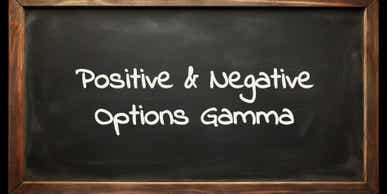What is Options Gamma?

What is Options Gamma?
Positive and negative options gamma explained
- Options gamma measures how options delta changes as the underlying stock price changes.
- Long options have positive gamma, which means the delta changes in the same direction as the stock price movement.
- Short options have negative gamma, which means the delta changes in the opposite direction of the stock price movement.
Often in the financial markets, there are two ways to understand something—mathematically and intuitively. Looking at options gamma mathematically, gamma is a second derivative of the Black-Scholes options pricing model (BSM).
Specifically, gamma is a partial derivative of the model taken with respect to price once and then twice. Given that we know options delta is a first derivative of the BSM with respect to price, gamma then effectively measures how delta itself changes when the underlying stock price changes.
Intuitively, the best way to explain gamma, just in a general sense, is to think of a car that's already moving. Its motion is measured basically by two different metrics: the car's speed and its acceleration. Well, in this context, the car's speed would be the delta, and its acceleration would be the gamma, so gamma shows how quickly something already moving (the delta) moves itself.
Positive gamma
Like what you would find with options vega, long options have positive gamma, or long gamma, and short options have negative gamma, or short gamma. Positive gamma means that your delta is going to change in the same direction as the stock price movement. Negative gamma means your delta is going to change in the opposite direction of the stock price movement.
So, for example, if you have a long call, then you’re positive gamma. That means if the stock goes up, your delta will go up, and if the stock goes down, your delta will go down. In other words, as the stock rises and your strategy works, your directional bias strengthens (you become more bullish). But if the stock falls and your strategy doesn’t work, your directional bias weakens (you become less bullish).
Negative gamma
Conversely, if you have a short call, then you’re negative gamma. If the stock goes up—the opposite of what you want—your delta goes down. More specifically, in this case it means it will become more negative, and thus you will be even more bearish than you were to start. But if the stock were to actually go down—what you want—then your delta will increase or, more specifically, become less negative, meaning you become less bearish as the strategy works in your favor.
Jim Schultz, a quantitative expert and finance Ph.D., has been trading the markets for nearly two decades. He hosts From Theory to Practice, Monday-Friday on tastylive, where he explains theoretical trading concepts and provides a practical application of those concepts to a trading portfolio. @jschultzf3
For live daily programming, market news and commentary, visit tastylive or the YouTube channels tastylive (for options traders), and tastyliveTrending for stocks, futures, forex & macro.
Trade with a better broker, open a tastytrade account today. tastylive, Inc. and tastytrade, Inc. are separate but affiliated companies.
Options involve risk and are not suitable for all investors. Please read Characteristics and Risks of Standardized Options before deciding to invest in options.